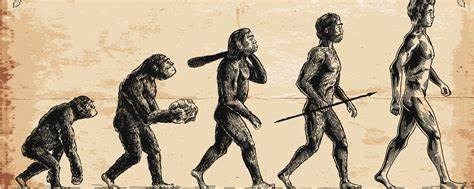Having progressed chronologically through the first primates, anthropoids, and then apes, we finally arrive at the emergence of hominins.
Hominins are a group of apes made up of humans and every primate on our lineage until the last common ancestor we share with chimpanzees and bonobos, or the panins.
This split occurred around 7 million years ago, at the very end of the Miocene epoch, and gave rise to an incredibly successful radiation of hominoids.
Hominins have morphologies that span the differences between modern humans and the last common ancestor we share with the panins.
Compared to a Miocene ape, humans have smaller teeth, a characteristic that is most overt in our canines.
We also have larger brains, and when endocasts can be taken, our brains show a unique pattern of organization.
We have a flatter, or orthognathic face compared to other living apes, and a weak browridge.
Humans are bipedal, which encompasses numerous skeletal traits that are thus starkly different between us and an arboreal Miocene ape.
This includes an anterior foramen magnum, a valgus knee, unique foot morphology, long hind limbs, an “s” shaped vertebral column, and a bowl shaped pelvis, among other more minute characteristics.
Humans also use a wide range of tools and have a bony protuberance we call a chin.
These traits emerge slowly over time through the hominin lineage until our own species, Homo sapiens, which presents them all.
Keeping with the nature of evolution, this also means that the first hominins are difficult to spot, but should in theory present a handful of hominin characteristics.
Sahelanthropus tchadensis was found in Chad around the year 2000, and it lived 7 million years ago, weighing in at around the size of a small chimpanzee.
Unlike many other apes of the Miocene, it has smaller canine teeth in both sexes, which may suggest that male competition was lower.
This ape also has a foramen magnum located more anteriorly, suggesting that it may have moved bipedally when on the ground.
Other aspects of the basicranium also appear more similar to hominins than to panins or gorillins, including the flatter nuchal plane.
Recent work on newly published postcrania, including a portion of the femur and two ulnae, suggests that the arms are very “ape-like” while the legs have derived “hominin-like” aspects.
How often Sahelanthropus tchadensis moved terrestrially, however, is still up for debate.
This is due in part to the relatively scant material attributed to this hominin.
Orrorin tugenensis is a much clearer case, at least with regard to locomotion.
Orrorin tugenensis was found in the Tugen hills of Kenya, also around 2000, and is dated to 6 million years ago, probably weighing about the same as Sahelanthropus tchadensis.
It is also known from very little material, but the head of the femur appears to be unambiguously that of a biped, at least when on the ground.
This is evidenced primarily by the distribution of cortical bone in the neck of the femur, which looks much more similar to a modern human than a non-human ape.
However, outside of the rather small sample of fossils, Orrorin is not well represented, and any concrete placement of this hominin remains to be seen.
This is not the case for the next hominin, Ardipithecus.
Ardipithecus is a genus that lived 4-5 million years ago, and is almost certainly a hominin, if a strange one.
It was found in the Afar region of Ethiopia, and is best known from a superb skeleton colloquially called “Ardi”, along with numerous isolated specimens.
It was originally discovered in the 1990s, but paleoanthropologists waited until 2009 to publish on it in order to properly analyze the full skeleton.
Because of its excellent representation, there is a lot we can say about this hominin.
Although there are two species, Ardipithecus kadabba and Ardipithecus ramidus, we will focus on the better preserved latter species.
Ardipithecus has smaller canines than the Miocene apes before it, and these teeth are the same size in males and females.
Not only that, but Ardipithecus males and females also had the same body size.
This is interesting in part because humans are unique among living hominids in being fairly monomorphic in stature and mass.
If living behaviors and morphologies are to be informative, this suggests Ardipithecus may have been a pair bonded or monogamous primate, much like modern gibbons and callitrichines.
Ardipithecus also has several of the traits of a biped: an anterior foramen magnum and a more bowl-shaped pelvis.
These telltale biped signs are astonishingly paired with a divergent big toe, even more divergent than what we see in modern chimps.
Additionally, Ardipithecus had a single foot arch: one more than chimps but still shy of the 3 human arches.
This odd suite of traits suggests that Ardipithecus was a biped when on the ground, but that it was still spending a substantial amount of time in the trees, where the toe aided in gripping.
It has been suggested that the divergent hallux, the strange big toe, may have been oblique during the stance phase of locomotion, or standing still, but shunted forward during toe offs.
The argument that Ardipithecus was bipedal when on the ground is contextualized by the relationship between its various characteristics.
For instance, although the divergent hallux would have made it a more awkward biped than humans, or even Australopiths, which we will investigate next, it would have been capable of habitual bipedality thanks to the other characteristics in its repertoire: the anterior foramen magnum, more sagittal iliac blades, and semi-valgus knee.
Critically, these latter traits biomechanically make quadrupedalism impossible, while the divergent hallux simply complicates bipedalism.
So what kind of environmental pressures result in a capable arboreal ape that can also get by on the ground?
Using isotopic work, the environment reconstructed for Ardipithecus is woodland, a habitat generally characterized by clusters of trees interrupted by open grassland.
This is precisely the environment that would favor an animal that is primarily arboreal,but needs the morphologic tools to travel between tree patches.
And much like gibbons today, if the animal is upright in the trees, it will be upright on the ground.
Overall, the mosaic locomotor style of Ardipithecus, along with its reduced canine teeth, suggest it was almost certainly a hominin, albeit an early and strange one.
All of these early hominins lived in Africa, with Sahelanthropus tchadensis being found in Chad, Ororrin tugenensis in Kenya, and Ardipithecus in Ethiopia.
Further, the next genus we are going to discuss, Australopithecus, is also found in Africa.
This suggests of course that humans evolved in Africa as well, and this is a notion that is supported by all modern genetic work on the subject.
Let’s move forward in the timeline and examine Australopithecus next.
The First Hominins



